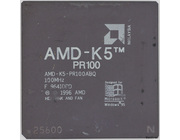AMD's first in-house developed x86 processor to match the Pentium. It was introduced in March 1996.
Although the AMD K5 was clock-for-clock faster than the Pentium, it did not do well. Pentium was released in 1993 (and faster parts in 1994) and used a smaller and more efficient design.
Internally it is a highly parallel 29k RISC processor with an x86 decoding front-end. It has 4.3 million transistors with five integer units that can proces instructions out of order.
Just like this one but one week older. > Read more
Just like the PR75 but somewhat faster. > Read more
A lot like the 5k86 P75 but then with normal print that says K5 PR75. > Read more
An older version of the AMD K5. The normal AMD K5 processors have a different name and printing on the CPU. The name of this one looks more like the AMD Am5x86 -P75 which is technically a 486; this isn't.
Basically AMD wanted to launch the AMD K5 but was struck with problems in the branch predictor. AMD decided to disable the brach predictor and sell the CPU as 5k86 P75 (with SSA/5 core). Later when AMD fixed the branch predictor they started selling K5-marked CPU's across the board. The P75 to P100 still had the branch predictor disabled. The faster models like the PR133 used the 5k86 core (and yes, the corename is identical to the productname of this CPU) with the brand predictor enabled.
Because the PR133 performed better with the branch predictor enabled, AMD sold the AMD K5 using a PR-number rather than clock-frequency to avoid people from comparing the PR133 with a Pentium 120 because the PR133 ran at 116MHz. > Read more
The AMD K5 was AMD's first in-house x86 processor and was introduced in march 1996. The AMD K5 wasn't a big success at that time because it was delayed and AMD's 90MHz and 100MHz parts were introduced 2 full years later Intel's Pentium at 90MHz and 100MHz.
Architecture-wise the K5 was quite ambitious. The die consists of 4,3 million transistors which is quite a lot more compared to the Pentium P54C that has 3,3 million transistors. Because of this large design the K5 didn't scale well so it took AMD quite some effort to get faster parts on the market. > Read more





